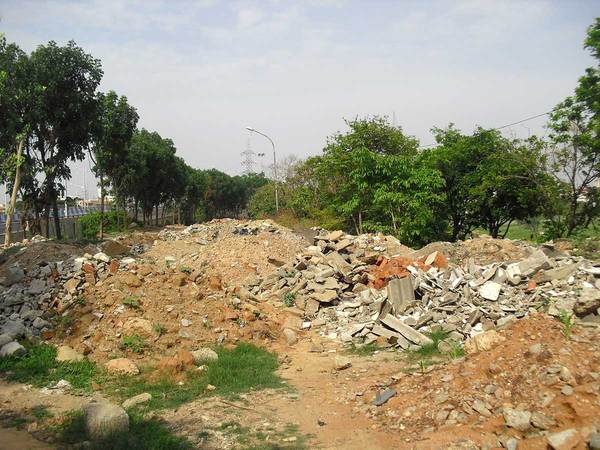It has been four years since Bangalore’s Lake Development Authority (LDA), put forward a bill demanding more power and funds to protect the city’s lakes. The wait seems endless for the cabinet’s approval of the proposed LDA bill. If passed, the bill will provide both resources and enforcement power to the LDA.

Construction debris being dumped on Agara Lake bed. Pic: Sankar C G
Strangely the ‘authority’ was formed under the Societies Registration Act, 1860, with practically no power to act against violators. “LDA is working like a society. Lack of resources is not allowing us for a full-fledged functioning. So we decided to propose a LDA bill in 2008,” says Rama Acharya, Public Information Officer, LDA.
LDA was formed in 2002 by Karnataka’s environment ministry. It has been funded by the State government.
According to LDA, Bangalore originally had 2785 lakes. People used lake water for domestic and agricultural activities. But due to industrialisation and urbanisation 90% of the lakes have vanished. But without teeth and resources to back it up, LDA is unable to do much.
Currently there are 207 lakes surviving. Of these BBMP is responsible for 129. BDA is in charge of 49 lakes, five are under Karnataka Forest Department, and 18 under Minor Irrigation Department and LDA itself controls only six lakes: Agara Lake (bounding HSR layout), Hebbal Lake, Nagavara Lake (near Hebbal), Venkayyana Kere (New Air port Road), Sheelavanthana Lake (Whitefield) and Byrasandra Lake (Jayanagar 3rd bock).
Non-existent enforcement currently
Taking care of even these six lakes has not been possible for the LDA. When Citizen Matters asked about the dumping of construction wastes and pollution in Agara Lake, Acharya said, “We cannot take action against those who are violating the lake. However, we have informed about this to the Revenue Department and KSPCB.”
What LDA seeks through the bill
1. Power to take action against lake encroachers.
2. Power to take action against lake polluters.
3. Enough resources for task forces, and sufficient engineers.
4. Bring more lakes under its ambit.
5. Sufficient funds for lake development.
LDA officials say their notices have been in vain. Eighteen cases are pending for the past two years with Karnataka State Pollution Control Board (KSPCB) with regard to the lake pollution.
Despite its lack of powers and funds, LDA has been able to do some work. Last year the authority did a lake water analysis on 86 lakes in Bangalore. 39 lakes were highly polluted and 47 moderately polluted.
But again, no action could be taken.
The long wait continues
“Once LDA bill is passed we will have enough resources and power. Then we can take action against those who are polluting or encroaching the lake. Moreover we will have enough resources to work for the preservation of lakes,” said Dr Ravi Ralph, CEO of LDA, echoing the line taken by his PRO, Acharya.
For a bill to become a law, it has to pass through different stages. But the LDA bill has not even passed the initial stages, since its drafting, says Ravi.⊕
Puthanahalli Lake in YELAHANKA used to be a birds sanctuary once upon a time. Toaday rapid encroachment by leading builders ,dumping of building materials, and growth of weeds have shrunk the lake and also the presence is diminishing.
Will the authorities wake up to revive atleast the left over part of the lake
This is one area where only the local administration and state government is to blame. Most property developers are part of the political fraternity and ensure that there is no one to check encroachment of lakes.
Can be addressed only with RWAs step up and indulging in activism to stop this. But RWAs consist of working folks who are more interested in watching “sas bahu” serials in the evenings than spending time on public issues. So there is no effective public push also.
Suhas